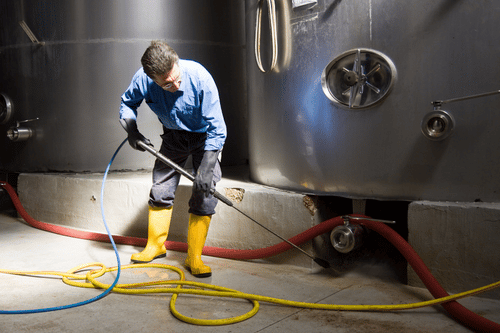Industrial cleaning to improve safety in your workplace

Industrial accidents can have devastating consequences for both workers and businesses. However, by having processes such as industrial cleaning in place, you can help to improve safety measures within your workplace.
What is industrial cleaning?
Industrial cleaning refers to the process of removing dirt, grime, and other contaminants from machinery, equipment, and workspaces in industrial settings. This can include a range of techniques and methods, from high-pressure cleaning to chemical treatments. The goal of industrial cleaning is to maintain a clean and safe working environment, prevent equipment failure and downtime, and extend the lifespan of machinery and equipment.
How can industrial cleaning help prevent accidents?
There are several ways that industrial cleaning can contribute to a safer work environment. Firstly, by removing dirt, dust, and other debris from machinery and equipment, you can help ensure that they are functioning at their optimal level. This can help reduce the risk of equipment failure, breakdowns, and other malfunctions that can lead to accidents.
Secondly, by maintaining a clean and tidy work environment, you can reduce the risk of slips, trips, and falls. This is particularly important in industrial settings where there may be hazards such as spills, oily surfaces, or uneven flooring.
Finally, by using the right cleaning methods and products, you can help prevent the buildup of harmful chemicals and toxins that can pose health risks to workers. For example, regular cleaning of ventilation systems can help prevent the accumulation of dust and other particles that can cause respiratory problems.
What are the most common types of industrial cleaning?
There are many different types of industrial cleaning, and the specific techniques and methods used will depend on the type of machinery and equipment being cleaned, as well as the nature of the contaminants being removed. Some of the most common types of industrial cleaning include high-pressure cleaning, chemical cleaning, steam cleaning, and dry ice blasting.
High-pressure cleaning involves using a powerful jet of water to remove dirt and grime from surfaces. Chemical cleaning involves using specially formulated chemicals to break down and remove contaminants. Steam cleaning uses high-temperature steam to clean and sanitize surfaces, while dry ice blasting involves using dry ice pellets to blast away dirt and grime.
How often should industrial cleaning be carried out?
The frequency of industrial cleaning will depend on a range of factors, including the type of machinery and equipment being cleaned, the nature of the contaminants present, and the working environment. In general, industrial cleaning should be carried out on a regular basis, with some areas and equipment requiring more frequent cleaning than others.
It’s important to establish a cleaning schedule that takes into account these factors, as well as any legal requirements or industry standards that apply. Regular inspections and maintenance can also help identify areas that require more frequent cleaning or attention.
Our industrial cleaning and commercial drainage services
At Mantank Environmental Services we provide industrial cleaning, waste removal and commercial drainage services. Most industrial accidents can be avoided easily by properly maintaining your workspace; therefore, our services are tailored to helping your teams keep safe in the workplace.
We have invested heavily in our equipment to ensure we can provide the best possible service to our clients.
Speak to our team
If you would like to know more about the industrial cleaning services we provide, do not hesitate to get in touch with our team. We work throughout the UK and provide a range of industrial cleaning and environmental services, all of which are suitable for businesses large and small.
To speak to our team simply fill in our contact form and we will be in touch as soon as possible.
